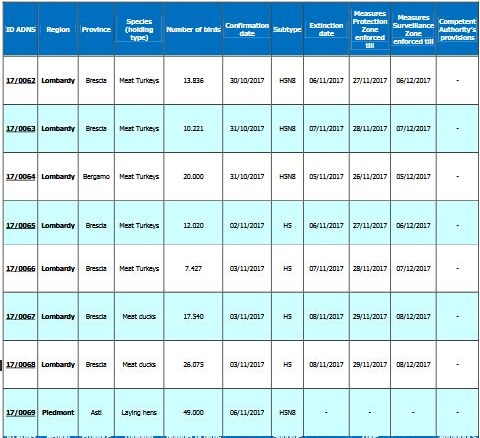 |
| Credit IZSV - HPAI H5 Outbreaks Since July |
#12,882
Although the IZSV website hasn't posted their standard narrative yet, they've updated their map and PDF files, showing 8 new poultry outbreaks since last Monday's report. Additional, Asti Province (circled on the map) reports their first outbreak of 2017.
The PDF file (see below) shows only one outbreak in Asti Province, but local reporting indicates there may be at least two.
I'll update this post with additional details if they are posted later today on the IZSV website.
The following media report in Republica suggests two farms (in Montechiaro and Montiglio) are involved, although only one is currently listed above. According to Google maps, the two towns are roughly 4 miles apart.
Asti, cases of bird flu in two farms: involved 50,000 hens
A Montechiaro and Montiglio. A decree of the fixed region in the three km protection zone
Mariachiara GIACOSA
November 6, 2017
Asti, cases of bird flu in two farms: involved 50,000 hens
There is a case of bird flu Astigiano. The alarm went off, the case for a "highly pathogenic" in Montechiaro and Montiglio after the analysis carried out by Zooprophylactic center of Turin. In all it would coivolte 50 thousand laying hens that can not be trasfertie to avoid contamination.
It is not excluded that they are torn down.
President Sergio Chiaparino Region has already signed a decree - which will now be sent to the local health authorities - to define a protection zone of 3 km around the farms where it was found the virus and the surveillance zone within a radius of 10 km. The virus, in fact, is technically capable of infecting the 'man but these measures serve to make the unlikely risk.
This heavy persistence of avian flu in Italy over the summer - and at much lower levels across other parts of Europe - is in sharp contrast to previous years when H5N8 all but disappeared in Europe and North America once spring ended (see PNAS: The Enigma Of Disappearing HPAI H5 In North American Migratory Waterfowl).
As we discussed in Avian Flu: That Was Then . . This Is Now, HPAI H5N8 has undergone dramatic evolutionary changes since 2016, and additional changes in its genetics and behavior are always possible.
